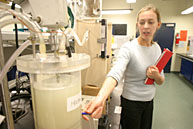Experiment with reality
The lab scene is familiar. A group of five undergraduate students, tag-team style, demonstrate a bio-filtration process for degrading the effluents in waste water produced by the local cheese industry. Behind them stand plexiglass buckets of murky liquid, connected to tubes, gauges and meters, all explained by a backdrop of charts and graphs. And before them stands Martin Weber, professor of chemical engineering, along with a phalanx of other faculty, TAs, students, and industry professionals. To the untutored eye, little distinguishes this scene from countless others enacted in universities across the continent. But Chemical Engineering 392/3, also known by the bland moniker "Project Lab," is unique in North America, and quite possibly the world. While this bio-filtration project is an educational exercise carried out as part of a required course, it is also performed at the request of Francis Enviro-Biotek, which has provided a problem -- and would like a solution.
 Chemical engineering student Elise Boulanger
Chemical engineering student Elise BoulangerPhoto: Owen Egan |
|
"The idea is to recreate as much as possible the work people really do in industrial R&D labs," says Weber, who helped the late Professor Maynard Fuller develop the course over twenty-five years ago. "Industry research takes a long time and involves a lot of things. It's not something you do in an afternoon," he explains. For instance, you need to know if your equipment is running and producing reliable information -- which is not an issue with most lab course work. In addition, real-world projects have an audience, someone who actually is looking for information. And once the solution is found, the experiment is retired. It isn't repeated a year later, for instance, as with most university course experiments.
So where to get these projects, which must be unique, of a manageable size, and not too dangerous? "The natural thing was to go to industry," says Weber. Participating companies range from the local, such as Francis Enviro-Biotek, to the global, such as DuPont and Monsanto. "We promise to pursue problems with 'due diligence,' but we make sure they understand that this research is being performed by students, not professional engineers, and that the goal is educational," he explains.
Students find the projects demanding, in terms of both ingenuity and time. The first step: meeting with an industry representative to discuss the problem. Then follow two semesters of learning the theory behind professional lab research, and putting it into practice: ordering or building the necessary materials and equipment, designing an experiment, testing and trouble-shooting it, and finally running it enough times to come up with an answer. "It's a lot of work. We were in the lab every day, taking samples at 9 a.m and 9 p.m." says Gilbert Lahdou. "Midnight was the latest." But despite the fatigue endured, course reviews are glowing. "It's a really good experience of lab work and problem solving," says Elise Boulanger. "A lot of things don't work the way you expect, so you have to find a solution." And because Weber makes up the research teams, students end up working with people they may not know -- another real-life challenge.
As the projects near their conclusion, the students organize their demonstration day -- a chance for groups to hone presentation skills, get some professorial feedback, and meet again with the industry representative. This year's event, March 20, was Weber's last, at least as the course teacher. He is joining the ranks of the emeriti this June, after coming to McGill from MIT in 1965. "I couldn't imagine being involved in something for 25 years if it weren't so enjoyable and stimulating," he attests. "It's been different every year." Weber's successor has not yet been named, but the innovative and unique course he built means his impact will be felt by students for years to come.

